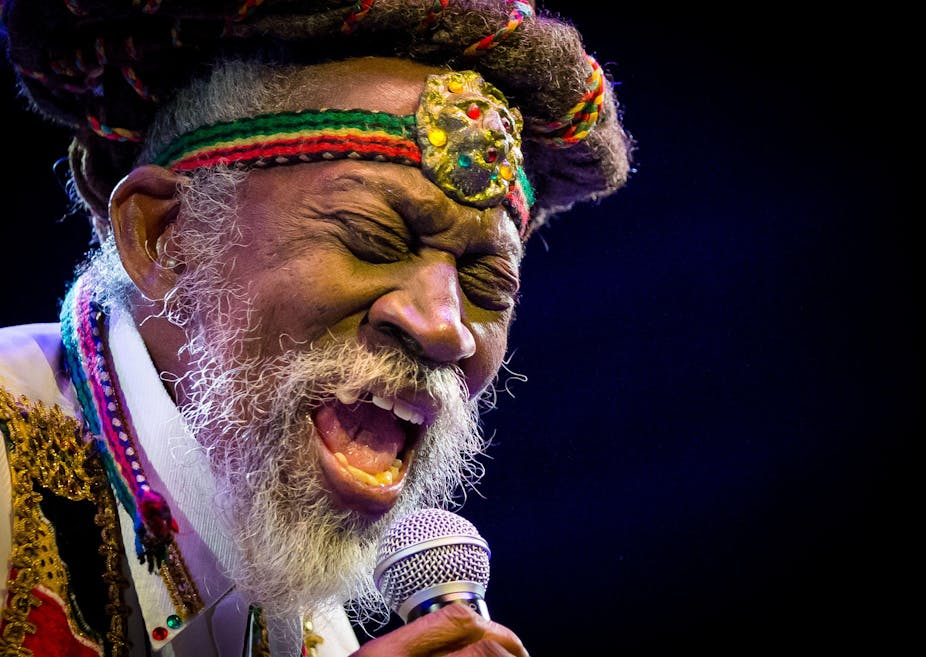The recent death of Bunny Wailer, the last surviving founding member of the Wailers has seen outpourings of grief and appreciation all over the world. But in the wake of the triple Grammy award-winner’s passing at 73, the pioneer’s contributions to reggae are being revisited by those who understand the full scope of his impact on reggae – and many more genres besides.
I met Bunny during the Wailers’ 1973 UK tour in Manchester, when members included Bob Marley, Peter Tosh and Bunny himself. My student band wanted to replicate the reggae sound we heard in songs like Stir it Up, when Bunny and Peter sang harmonious backing vocals for Bob.
Bunny was deep and considered when talking about his music, checking to see if we understood the central messages of resistance, Rastafarianism and black liberation. The Wailers were about to change the face of popular music then. But to grasp how they shaped their iconic sound, you should understand the surroundings that moulded them as musicians.
The birth of the Wailers
Bunny was born Neville O’Riley Livingston in Kingston, Jamaica, on April 10 1947. He moved to the district of Nine Mile, a rural region in the St Ann parish of Jamaica, as a child. It was there that he met Bob years before either of them made their stamp on the world.
St Ann’s strong history of producing other luminaries, such as pan African leader Marcus Garvey, would’ve provided fertile ground for Bunny’s budding interest in black power and independence politics. Moving from the tranquil, “easy-living” countryside of Nine Mile to the harshness of downtown Kingston would’ve had a similar effect on Bunny’s views and music, strengthening those interests into something more concrete through the city’s proliferation of sound systems and recording studios.
By 1957, Bunny and Bob began to learn their craft through Joe Higgs, an influential musician and producer who worked with famous sound system innovator and record producer Coxsone Dodd. While developing, mentoring and recording new music talent in the 1960s, Higgs introduced the pair to Peter Tosh, who became the third original Wailers’ member.
Jamaica’s music renaissance
The three teenagers were stimulated by the fast-paced 1960s Kingston music scene, where enterprising musicians and budding entrepreneurs developed new styles like ska, rocksteady, roots reggae and dub, setting trends that became popular and eventually influenced global music. Suddenly, after years of relative obscurity, Jamaican musicians, producers and songwriters had opportunities to promote and distribute their records into the UK and then around the world.
This mindset of innovation was the backbone of Jamaican sound systems. As well as the wider Jamaican music industry, the Kingston scene also shaped the early Wailers’ ska sound. By 1964, Bob, Bunny and Peter had their first number one hit in Jamaica, “Simmer Down”, a message to gangs in Kingston to “cool down” crime and political-related violence.

By the time the Barrett brothers joined the band to play drum and bass, the Wailers’ sound had evolved from ska to an intoxicating mix of political lyricism, strong rhythms, rock guitar riffs and synthesisers. This formed the basis of roots reggae (as heard on the Wailers’ fifth album, Catch a Fire).
Rastology (a term used by scholars and Rastas to represent Rastafarian philosophy, spirituality, lifestyle and cultural practices) has remained a constant throughout the genre. As reggae and its sub-genres like dub and dancehall have evolved, Rastology has been appropriated and expressed through what I term “sonic livity”.
In Rastology, “livity” denotes the Rastafarian way of living and being. It’s the consciousness that flows from the belief, experience and expression of Jah (God) in oneself. This is often voiced in Rasta vernacular as “I and I”. The first “I” describes Jah (God) connecting to the second “I”, the individual.
The “I and I” relationship is believed to be intensified through sonics (sound frequency vibrations). Whether expressed through Nyabinghi drumming, worship, singing, rhythms, dub or sound systems, sonic livity aims to be upful (positive) and intentional music created to promote “one love” in humanity.
When Bunny left the Wailers in 1973 following a creative clash of ideas with the group, he grounded himself even further in these concepts, rooting himself in Jamaica, where he continued to live his semi-rural Rastafarian lifestyle. His first album, Blackheart Man (1976), shows the extent of that influence, with songs like Fighting Against Conviction (Battering Down Sentence) reinforcing his ideas and experiences about Rastafarianism, black identity and politics.
Bunny’s peers (some of whom also died recently) were also integral to Jamaica’s musical renaissance following the country’s 1962 independence from the UK. The likes of Desmond Dekker, Alton Ellis, Marcia Griffiths, Toots and the Maytals, U Roy, Lee “Scratch” Perry, Milly Small and others created catalogues of musical hits that anchored Jamaica’s place in global pop culture. Through the work of musicians like these, reggae has been recognised by UNESCO as an “intangible cultural heritage of humanity” worthy of protection and preservation.
In the past decade, a new generation of young Jamaican musicians like Protoje, Jah9, Chronixx, Jessie Royal, Koffee, Kelissa and Kabaka Pyramid have emerged, inspired by roots reggae musicians like Bunny Wailer. There’s a resurgence of “conscious reggae” – reggae music with life-affirming, positive and political lyrics.
With lines like “Africa inna we soul but a Jah inna we heart”, Protoje’s hit song Who Knows is a perfect example. Songs like “I Can” by Chronixx and “In The Midst” by Jah9 also echo sentiments of Jah, love, self-development and liberation, all of which appeared throughout Bunny’s discography.
By embracing social and new technology emerging reggae artists are pushing the boundaries of the genre, reaching wider audiences and continuing in the tradition of spreading spirituality and positivity through song. With few of the pioneers of the genres that inspired this new cohort left, it seems their messages about resistance, equality, black power, and social justice have endured.

